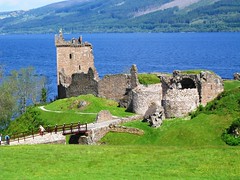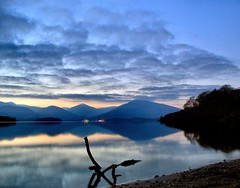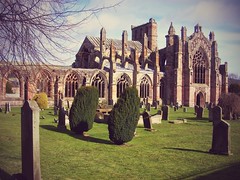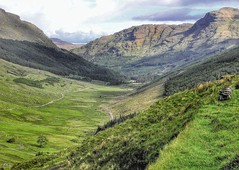Robert Burns rock 'n' roll star
ALLOWAY TO THE TOP OF THE CHARTS
 Elvis Presley eat your heart out - Hamish Burns learns that Scotland's
national bard Robert Burns out-shocked the rock stars of the modern
era.
Elvis Presley eat your heart out - Hamish Burns learns that Scotland's
national bard Robert Burns out-shocked the rock stars of the modern
era.
Wild parties, drunkenness, music and loose women are all associated with the morally wayward life of the rock star - from Elvis Presley to Liam Gallagher, their tales of excess are still a source of tabloid filling fascination.
But more than 200 years ago, during an age of strict morality, Scotland's national poet out-partied them all. For Robert Burns, whisky was the drug, outrageous poetry was the rock 'n' roll and sex was, well, sex.
The bard is famous both for his drinking and his womanising - that much is clear from the tales of rowdy alehouses and the seemingly endless list of women's names which appear in his work. Clarinda, Jean, Anna, Kate and numerous unnamed "Bonnie Lasses" are among those who caught the Burns eye, many of them falling to his charms.
But while Burns had a way with women which at the time offended the God fearing community in which he lived, what is less well known is that he had a way with words which would offend the censors in even today's sexually promiscuous society.
Or as Nat Edwards, general manager of the Burns National Heritage Park puts it, "It would make Eminem blush." The rap artist has attracted controversy for lyrics of the sort which your mother definitely wouldn't like. Recent recordings of Burns's lesser known works, however, have also been deemed worthy of a "parental guidance advised" sticker on the front.
Burns was not shy of using "industrial language" in his work, notably the "Merry Muses of Caledonia." The sexual appetites and bodily functions of both men and the women with whom Burns consorted with are plain to see in poems like "Nine Inches Will Please a Lady", "Hoo Can I Keep My Maidenheid" and "My Girl She's Airy".
These volumes were suppressed in Victorian times and indeed during his own lifetime Burns was advised to tone down his writings to maximise his commercial impact among the genteel classes of 18th century Scotland.
Burns became a "rock star" of his time partly because of the huge cult that grew up around him. By the time he set off for Edinburgh in 1786 he had developed something of a celebrity status. What is now known as "The Kilmarnock Edition", his first published work, had been well received and the glitterati of the capital awaited his arrival with excitement.
Even ordinary folk whom he met on his way to meet publishers in Edinburgh had learned not just of his fame as a poet but also of his reputation as a party animal.
"In his work are wonderful sexual encounters and moments of madness - in a lot of ways a lifestyle just like a rock 'n' roll star. He also has a iconic status - just like James Dean or Marilyn Monroe, his image is one that we all recognise immediately," says Nat.
"Even in his own lifetime he had begun to take on that sort of image. It took three days for him to get from Ayr to Edinburgh to meet his publisher because he was invited in to almost every farm on the route to recite poetry and also to drink. They wanted to see if he could live up to his reputation as a drinker and test himself against the best of the locals."
But Burns does not deserve the status of a rock star simply because of his debauched behaviour. His championing of freedom, his opposition to the dominant Calvinist attitudes of the day would nestle comfortably with the attitudes of 1960s musicians and in particular the hippy movement.
Burns was himself forced to undergo penance at his local church after bedding a string of local women and fathering children by several of them out of wedlock. For Burns to admit that his chosen lifestyle was sinful was a massive humiliation and one which he resented.
Nat explained, "He had a very chequered life, with a very open set of values and he was very happy to confront bigotry and hypocrisy. He was outspoken about the establishment, the church, politics, sex, and the morals of the time."
Even Burns' style of poetry helps him lay claim to inventing the spirit of rock 'n' roll. Whereas poets of the time saw their work as something that should be carried out in the controlled environment of a study, with time to reflect, Burns would write any time, any place, anywhere he chose, whether on horseback or blazing drunk in the middle of a noisy inn.
"He scratched poems into the panes of glass in alehouse windows using a ring and he would also write on walls," says Nat.
"He was very much a part of the modern tradition. Poets at that time, like Wordsworth, believed that you should reel in your emotions - that poetry should be written in the same way that artists paint in a studio. Burns was the opposite and that was a very modern, much more rock 'n' roll approach to life."
The similarities have been picked up by Carol McGuirk, professor of English at Florida Atlantic University. She believes the growth of a cult of Burns was similar to the Elvis Presley mania that swept the world in the 1950s and 60s. The two also shared an impressive pair of sideburns, which the Burns Heritage Park now plays upon in a poster campaign depicting the bard as the man from Memphis.
Burns Suppers and the rigmarole which surrounds Burns night are often associated by the younger generation with a formality and ritual that bears no resemblance to the sort of gatherings the man himself would have attended. Nat hopes that comparisons of Burns with modern day rock stars will help rekindle youthful interest in the biggest star ever to have been produced by this country.
Just be careful which CD the kids buy.
You can find out more about Scotland's early rock 'n' roller at the Burns Heritage Park in Alloway, Ayrshire or visit the website at www.robertburns.org
Our very own Robert Burns website at www.rabbie-burns.com also has a wealth of information on the Scots bard and Burns Suppers.
The above image has been adapted from a poster campaign used by the Burns Heritage Park.
(24/1/2002)
Back








